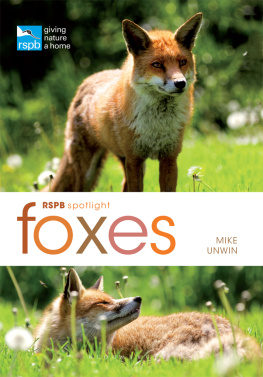

The RSPB is the countrys largest nature conservation charity, inspiring everyone to give nature a home so that birds and wildlife can thrive again.
By buying this book you are helping to fund The RSPBs conservation work.
If you would like to know more about The RSPB, visit the website at www.rspb.org.uk or write to: The RSPB, The Lodge, Sandy, Bedfordshire, SG19 2DL 01767 680551.
Bloomsbury Natural History
An imprint of Bloomsbury Publishing Plc
| 50 Bedford Square | 1385 Broadway |
| London | New York |
| WC1B 3DP | NY 10018 |
| UK | USA |
www.bloomsbury.com
Bloomsbury is a trademark of Bloomsbury Publishing plc
This electronic edition published in 2015 by Bloomsbury Publishing Plc
First published 2015
text, Mike Unwin, 2015
photographs as credited , 2015
Mike Unwin has asserted his right under the Copyright, Designs and Patents Act, 1988, to be identified as Author of this work.
All rights reserved
You may not copy, distribute, transmit, reproduce or otherwise make available this publication (or any part of it) in any form, or by any means (including without limitation electronic, digital, optical, mechanical, photocopying, printing, recording or otherwise), without the prior written permission of the publisher. Any person who does any unauthorised act in relation to this publication may be liable to criminal prosecution and civil claims for damages.
No responsibility for loss caused to any individual or organization acting on or refraining from action as a result of the material in this publication can be accepted by Bloomsbury or the author.
British Library Cataloguing-in-Publication Data
A catalogue record for this book is available from the British Library.
Library of Congress Cataloguing-in-Publication data has been applied for.
ISBN: PB: 978-1-4729-1209-1
ePDF: 978-1-4729-2206-9
ePub: 978-1-4729-1210-7
To find out more about our authors and books visit www.bloomsbury.com. Here you will find extracts, author interviews, details of forthcoming events and the option to sign up for our newsletters.
Contents
Meet the Red Fox
Hero or villain? Few animals divide opinion like the Red Fox. This remarkable wild canine has lived cheek by jowl with people across the northern hemisphere for thousands of years. Celebrated by some for its resourcefulness and lush red coat, reviled by others for killing livestock and raiding bins, it has worked its way deep into culture, leaving fact sometimes hard to separate from fiction. However, behind the myth, folklore and lurid headlines lies a remarkable natural history success story.

Best foot forward: a Red Fox on a mission.
One reason why the Red Fox looms so large in our collective consciousness is its sheer visibility. Ironically, while the urban, industrial and agricultural transformations of our modern landscape have driven many wild British species into decline, Foxes have become steadily more conspicuous and successful. Indeed, for the average British suburbanite, this unmistakable wild animal our boldest terrestrial predator is probably the most commonly seen native mammal. While the urban myth persists that in London you are never more than a yard from a Rat, it is a safe bet that the average Londoner lays eyes on a Fox far more frequently.
Science tells us that the Red Fox is a member of the Vulpes genus of true foxes, one of 10 genera in the dog family Canidae. It is the only species of wild canid found in the UK and enjoys the widest natural distribution of any non-human land mammal on the planet. Science also explains how the species great versatility, including a catholic diet and broad habitat tolerance, has allowed it to survive and adapt where other carnivores have failed not least in the hearts of our cities.
Science, of course, is not the whole story. Something about this charismatic animal a creature that has, for better or worse, become the living embodiment of wily has driven it deep into our culture, imagination and even politics. To understand how this has happened, we must take a closer look at the animal itself.

An emblem depicting a Fox and a goose in the town hall in Vohenstrauss, Bavaria, Germany.
Worldwide wanderer
The Red Fox (Vulpes vulpes), known in the UK simply as the Fox, is the most widespread and numerous of about 22 species around the world that bear the name fox. It is found not only throughout the British Isles and mainland Europe, but also ranges east through Asia as far as Japan, west across North America to Alaska, and south to India, the Middle East and the northern fringes of Africa. To the north the frozen Arctic tundra provides a natural range limit, and the species is absent from many Arctic islands, including Greenland, although climate change may already be helping it to surmount this barrier.

A warm winter coat protects the Red Fox in cold climates.
Add to this natural range the Foxs successful colonisation of Australia, where it was introduced during the mid-1800s, and the total area over which it roams adds up to some 70 million sq km (more than 27 million sq miles). This gives the Red Fox, after our own species, the most extensive natural range of any land mammal on the planet. In other words, our Fox an animal inseparable from the British notion of the British countryside is a highly cosmopolitan species. Indeed, some scientists have proposed more than 48 subspecies around the globe.

The worldwide distribution of the Red Fox.

Graveyards offer plentiful refuges for urban Red Foxes.
The key to this global success is the Foxs ability to get on in almost any habitat. It occurs in forests, mountains, moorland, grassland, farmland, urban areas and desert fringes, ranging from sea level up to an altitude of 3,000m (9,845ft), sometimes more. Its essential needs are food and denning sites, and Foxes tend to fare best in mixed landscapes those comprising, for example, a hotchpotch of woodland, farmland and scrub where they find plenty of both. Thus homogenous habitats, such as dense forests or barren uplands, may support just one Red Fox per 45 sq km (12 sq miles), whereas more varied ones, such as farmland and deciduous woodland, typically support 12 Foxes per square kilometre.
The last UK Red Fox census, taken in 19992000, suggested a stable overall population of some 230,000 animals, before cubs are born. This averages out at roughly two Foxes per square kilometre across the country. However, population densities vary hugely by habitat. Remote Scottish hill country may support just one Fox per 30 sq km (11 sq miles), whereas urban areas may support 45 Foxes in just a single square kilometre. Indeed, during the early 1990s, Bristol city centre boasted an astonishing 37 Foxes per square kilometre the highest population density ever recorded anywhere.
Next page





















